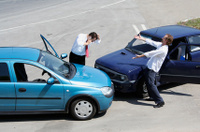 The traffic light at the intersection of Sahara and Fort Apache was green for east-west travel. Raymond Yeghiazarian, travelling westbound, wanted to turn left on a permissive green ball.
The traffic light at the intersection of Sahara and Fort Apache was green for east-west travel. Raymond Yeghiazarian, travelling westbound, wanted to turn left on a permissive green ball.
Heading eastbound in his patrol car was LVMPD Officer Jared Wicks. Running without lights or siren, Officer Wicks was travelling faster than the posted speed limit of 45 mph. Yeghiazarian made his left turn in front the oncoming Officer. The two collided in the intersection.
Yeghiazarian suffered severe injuries and died three weeks later. His family filed wrongful death claims against Officer Wicks and the LVMPD. NRS 41.085.
At trial, one thing that everyone agreed with was that Mr. Yeghiazarian failed to yield the right-of-way. NRS 484B.253 says that at an intersection, the vehicle turning left has a duty to yield to oncoming traffic.
In addition, there was no doubt that Officer Wick was speeding. The question was how much? The defense expert who investigated at the scene and reviewed the data collected from the Officer’s patrol car said that Wicks was going 58 mph. The Plaintiff’s expert, who didn’t investigate at the scene but looked at photos and the same data said over defense of objection that the Officer was going 74 mph.
Probably most important was the agreement between the experts that if Officer Wicks had been going 45 mph, Mr. Yeghiazairan would have cleared the intersection without an accident.
In spite of the right-of-way violation, the jury found the Officer 75% at fault and Mr. Yeghiazarian 25% at fault. LVMPD appealed on a number of grounds.
The Nevada Supreme Court upheld the jury’s verdict in it opinion of LVMPD v. Yeghiazarian, 129 Nev.Adv.Op. 81, 312 P.3d 503 (2013), in which it sustained the trial court’s decision to allow the Plaintiff’s expert to testify. The court said:
The fact that Plaintiff’s expert Dr. Baker chose to use the longer measurement instead of the shorter measurement for the skid marks was an appropriate topic for cross-examination. Further, the disagreement among Dr. Baker and others regarding Officer Wicks’ pre-braking speed was founded on whether the figures from the “black box” in Officer Wicks’ patrol car or from the airbag accelerometer were more reliable in determining impact speed—also an appropriate topic for cross-examination. The record indicates that Plaintiff’s expert Dr. Baker was able to calculate to a reasonable degree of scientific certainty the vehicles’ starting positions, their pre-braking and impact speeds, and the general angle at which the vehicles collided. Therefore, we cannot say the district court abused its discretion by allowing Plaintiff’s expert Dr. Baker to testify.
In other words, when it comes to a comparative fault analysis, the Supreme Court agreed with the jury that a driver who has the right-of-way will not unfailingly prevail over the driver who did not yield.
If you have questions about how comparative fault works in Nevada, contact Mike Mills. He will gladly talk to you at 702-240-6060. Also, be sure to follow this on other Nevada Law Blogs.
 Follow
Follow Email
Email


